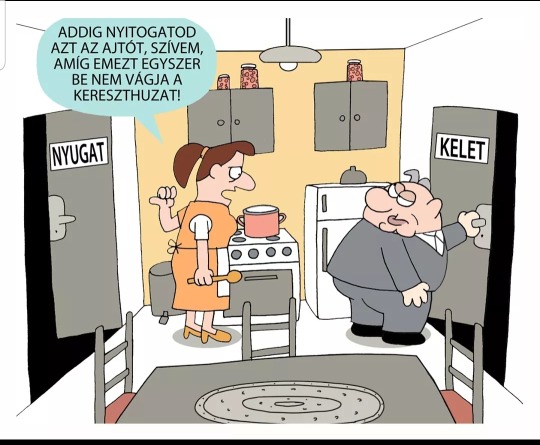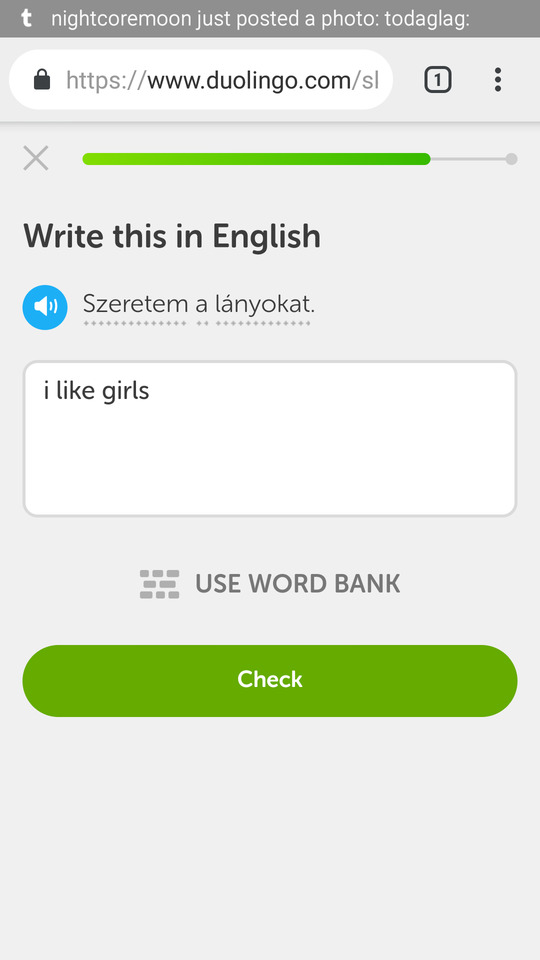Text
Great, but "asszongya" is no longer used widely and can't recommend it to language learners.
hát, ugye, ööö, "nem is tudom", hmmm, tudod, izé, szerintem would all work depending on the context. (i.e. depending on whether you're trying to come up with something to say or can't find a word)
In linguistics, a filler is a sound or word that is spoken in conversation by one participant to signal to others that he/she has paused to think but is not yet finished speaking. These are not to be confused with placeholder names, such as thingamajig, which refer to objects or people whose names are temporarily forgotten, irrelevant, or unknown.
In Afrikaans, ah, em, and eh are common fillers.
In Arabic, يعني yaʿni (“I mean”) and وﷲ wallāh(i) (“by God”) are common fillers.[2][3][4]
In American Sign Language, UM can be signed with open-8 held at chin, palm in, eyebrows down (similar to FAVORITE); or bilateral symmetric bent-V, palm out, repeated axial rotation of wrist (similar to QUOTE).
In Bengali, mane (“it means”) is a common filler.
In Catalan, eh /ə/, doncs (“so”), llavors (“therefore”), and o sigui (“it means”) are common fillers.
In Czech, tak or takže (“so”), prostě (“simply”), jako (“like”) are used as fillers. Čili (“or”) and že (“that”, a conjunction) might also be others. A person who says jako and prostě as fillers might sound a bit simple-minded to others.[5]
In Danish, øh is one of the most common fillers.
In Dutch, eh, ehm, and dus are some of the more common fillers.
In Esperanto, do (“therefore”) is the most common filler.
In Filipino, ah, eh, ay, and ano are the most common fillers.
In Finnish, niinku (“like”), tota, and öö are the most common fillers.
In French, euh /ø/ is most common; other words used as fillers include quoi (“what”), bah, ben (“well”), tu vois (“you see”), and eh bien (roughly “well”, as in “Well, I’m not sure”). Outside of France, other expressions are tu sais (“you know”), t’sais’veux dire? (“you know what I mean?”), or allez une fois (“go one time”). Additional filler words include genre (“kind”), comme (“like”), and style (“style”; “kind”)
In German, a more extensive series of filler words, called modal particles, exists, which actually do give the sentence some meaning. More traditional filler words are äh /ɛː/, hm, so /zoː/, tja, and eigentlich (“actually”)
In Hebrew, eh is the most common filler. Em is also quite common.
In Hindi, matlab (“it means”) and “Mah” are fillers.
In Hungarian, common filler words include hát (well…) and asszongya (a variant of azt mondja, which means “it says here…”).
In Icelandic, a common filler is hérna (“here”). Þúst, a contraction of þú veist (“you know”), is popular among younger speakers.
In Indonesian (Bahasa Indonesia), anu is one of the most common fillers.
In Italian, common fillers include “tipo” (“like”), “ecco” (“there”) and “cioè” (“actually”)
In Irish Gaelic, abair /ˈabˠəɾʲ/ (“say”), bhoil /wɛlʲ/ (“well”), and era /ˈɛɾˠə/ are common fillers, along with emm as in Hiberno-English.
In Japanese, common fillers include eetto, ano, sono, and ee.
In Kannada,Matte for also,Enappa andre for the matter is are the common fillers.
In Korean, eung, eo, ge, and eum are commonly used as fillers.
In Lithuanian, nu, am and žinai (“you know”) are common fillers.
IN Maltese and Maltese English, mela (“then”), or just la, is a common filler.
In Mandarin Chinese, speakers often say 这个 zhège/zhèige (“this”) or 那个 nàge/nèige (“that”). Another common filler is 就 jìu (“just/precisely”).
In Norwegian, common fillers are øh, altså, på en måte (“in a way”), ikke sant (literally “not true?”, “no kidding”, or “exactly”), vel (“well”), and liksom (“like”). In Bergen, sant (“true”) is often used instead of ikke sant. In the Trøndelag region, skjø’ (“see?” or “understand?”) is also a common filler.
In Persian, bebin (“you see”), چیز “chiz” (“thing”), and مثلا masalan (“for instance”) are commonly-used filler words. As well as in Arabic and Urdu, يعني yaʿni (“I mean”) is also used in Persian. Also, eh is a common filler in Persian.
In Portuguese, tipo (“like”) is the most common filler.
In Romanian, deci /detʃʲ/ (“therefore”) is common, especially in school, and ă /ə/ is also very common (can be lengthened according to the pause in speech, rendered in writing as ăăă), whereas păi /pəj/ is widely used by almost anyone.
In Russian, fillers are called слова-паразиты (“vermin words”); the most common are Э-э (“eh”), это (“this”), того (“that”), ну (“well”), з��ачит (“it means”), так (“so”), как его (“what’s it [called]”), типа (“like”), and как бы (“[just] like”).
In Serbian, znači (“means”) and ovaj (“this”) are common fillers.
In Slovak, oné (“that”), tento (“this”), proste (“simply”), or akože are used as fillers. The Hungarian izé (or izí in its Slovak pronunciation) can also be heard, especially in parts of the country with a large Hungarian population. Ta is a filler typical of Eastern Slovak and one of the most parodied features.
In Slovene, pač (“but”, although it has lost that meaning in colloquial, and it is used as a means of explanation), a ne? (“right?”), and no (“well”) are some of the fillers common in central Slovenia, including Ljubljana.
In Spanish, fillers are called muletillas. Some of the most common in American Spanish are e /e/, este (“this”), and o sea (roughly means “I mean”).[6], in Spain the previous fillers are also used, but ¿Vale? (“right?”) and ¿no? are very common too.
In Swedish, fillers are called utfyllningsord; some of the most common are öhm, ja (“yes”), ba (comes from “bara”, which means “just”), asså or alltså (“therefore”, “thus”), va (comes from “vad”, which means “what”), and liksom and typ (both similar to the English “like”).
In Ukrainian, ой /ɔj/ is a common filler.
In Urdu, yani (“meaning…”), falan falan (“this and that”; “blah blah”), umm, and aaa are also common fillers.
In Telugu, ikkada entante (“Whats here is…”) and tarwatha (“then…”) are common and there are numerous like this.
In Tamil, paatheenga-na (“if you see…”) and apparam (“then…”) are common.
In Turkish, yani (“meaning…”), şey (“thing”), “işte” (“that is”), and falan (“as such”, “so on”) are common fillers.
In Welsh, de or ynde is used as a filler (loosely the equivalent of “You know?” or “Isn’t it?”). Ym… and Y… are used similarly to the English “um…”.
90K notes
·
View notes
Link
naccerű állatkerti séta!
korabeli fókák!
cserélhető kémpárok!
önmozgást végző célszemély!
teve! TEVE! <3
idegmaceráló zene!
drámai hirtelenséggel véget érő vég!
csak tessék csak tessék, soha vissza nem térő..!
17 notes
·
View notes
Photo

Overview
IPA & Pronunciation Videos
Pronunciation dictionary
Overview of the language
Summary
Grammar & Courses
Audio and Video Material
Aktív MagyarOK
Duolingo
Duolingo Grammar Notes
Easy Hungarian
Egy Kis Magyar
FSI Basic Hungarian Course
HeyLingo
How to learn Hungarian
Hungarian Reference
Hungarize
Hungarobox
Hungaryforyou Lessons
Hunglang Lessons
KaleidoVox
Lépésenként magyarul coursebooks and materials
Let’s Learn Hungarian
Magyaróra
Magyar-Tanulás Repository
Mondly Languages
Vocabulary
Ba Ba Dum
Clozemaster
Daily Magyar
Drops
Memrise: Hungarian Vocab I
Memrise: Hungarian Vocab II
Vocab List Magyar-Angol
Books & PDFs
A kis herceg
Alternative Dictionary
Colloquial Hungarian + Audio
Colloquial Hungarian Mistake List
Hungarian: An Essential Grammar
Hungarian Graded Reader
Jó szórakoszást magyarul
Lépésenként magyarul grammar notes
MEK: Free e-books
Teach Yourself Hungarian
Verb Reference Book
Dictionaries
Angolszótár
Bab.la
Etymological Dictionary
Linguee
Hunglish
Hungarian Multisearch
Sztaki szótár
Szinonimaszotar
Szotar
Thematic Dictionary
Topszótár
Wikiszótár
Media & Apps
88 Mérföld Óránként: Movie Podcast
Babelmatrix Hungarian Literature & Translation
Daráló: Coffee Podcast
Dual Language Angol-Magyar Stories
Filmio: Hungarian Movies (use VPN)
Folkradio: Folk songs
HelloTalk (for language practice)
Hungarian Pod 101
Hungarian Project Youtube Lessons
Hungarian with Sziszi
Hungarian Folktale Videos
Hungarian movies with subtitles
Index: Culture Podcast
Indirect Hungarian Videolessons
Kaszt: Several Hungarian Podcasts
Lépésenként magyarul 1: iOS | Android App
Let’s Learn Hungarian Podcast
Netflix shows available in Hungary
Magyar Tanulok Magazine
One Minute Hungarian
Quizzes
Space Bar: Sci-Fi Podcast
Szertár: Science Podcast
VOIZ: App for Audiobooks
Verb Blitz: iOS | Android App
Verb Conjugation iOS App
Zelk Zoltán: A három nyúl video
427 notes
·
View notes
Photo
Ezt félreteszem a diákjaimnak.

AFTER HOURS (1985)
2K notes
·
View notes
Video
youtube
Állásinterjú két verzióban.
Szint: B1-B2
Az interjúztató nagyon gyorsan beszél, ezért érdemes előtte átnézni a kérdéseket, de a válaszok jól érthetők.
0 notes
Link
ez borzasztó, de nagyon jó lesz magyarórára!
-> a pr részleg nagyon szeretné, ha maradhatna a helyén a felvásárlás után is
46 notes
·
View notes
Video
youtube
Felszólító mód.
0 notes
Video
Barátok Közt - Nóránál vakbélgyulladást fedeznek fel.
Téma: Betegségek, orvos
Szint: B1-B2
Kérdések:
Mi baja a kislánynak?
Mi baja Nórának?
0 notes
Video
youtube
Mikor van a főszezon?
Hova szeretnek leginkább menni a magyarok?
Hány napra szeretnek a magyarok nyaralni menni?
Mivel szeretnek utazni?
(B1-es szint.)
0 notes
Link
Ilyen kicsikkel az a jó, hogy még egy csomó minden nem unalmas: mindennel lehet a számokat és a színeket gyakoroltatni. Itt az új anyag a formák, alakok - ezeket a gyerekek általában 4 éves koruk körül sajátítják el az anyanyelvükön, úgyhogy izgalmas a másik nyelvükön is megtanulni.
(érdekes módon a felnőtt diákjaimnak soha nem jutott az eszembe megtanítani a formákat.)
0 notes
Link
Most nagy kihívás, hogy van egy hatéves diákom: vele még nem írunk és olvasunk (szeretne már egyébként, de a szakirodalom szerint először tanuljon meg rendesen írni meg olvasni az anyanyelvén, elég lesz jövőre összezavarni), úgyhogy sokat játszunk, színezünk, éneklünk és ISMÉTLÜNK.
Ezzel a két oldallal a “kicsi, nagy, sok, kevés” fogalmakat néztük át, és amikor az már nagyon jól ment, akkor a “kisebb, nagyobb, több, kevesebb” fogalmakat is.
Nyelvfüggetlen, vigyétek.
0 notes
Text
me: you remember how we said that infinitives (the words that end in -ni) don't change form?
my student: igen
me: you also remember how we said that with words like "tilos" and "szabad" we don't show who's the actor?
my student: igen, persze
me: guess what! ez nem igaz! (ördögi kacaj) csak azért mondtuk ezt, hogy meg ne ijedj.
imádok B1 magyart tanítani: végre elérkeztünk a "tilos kinyitnom az ajtót" és "szabad tévét nézniük" jellegű bámulatos szerkezetekhez.
(kár hogy együtt tanítja a tankönyv a "nem kell iskolába járniuk / nekik meg lehet ismerniük a titkokat" típusú szerkezetekkel, ami ránézésre pont ugyanaz, de tedd csak múlt időbe! hoppá! a kell és lehet igei (modális segédige), az érdemes / tilos meg melléknévi állítmanyok.
de ezt még nem mondtam el a diákomnak, mert nem akartam megijeszteni. honnan tudná hogy mi ige (kell, lehet, illik, sikerül) és mi nem (érdemes, tilos)?
és mi van a szabaddal? csak nem most változik igévé, éppen az orrunk előtt? https://m.nyest.hu/hirek/nem-szabadott-volna-vagy-nem-lett-volna-szabad)
(azt viszont elmondtam, hogy azért nem fogja ezeket túl gyakran használni, legalábbis nem ezekben a komplikált alakokban.)
1 note
·
View note
Photo

pezsgő [ˈpeʒɡøː] – champagne
[Literally::: sparkling / fizzing]
pezsegni [ˈpeʒeɡni] – to sparkle; to fizz
pezseg [ˈpeʒeɡni] – it sparkle; it fizzes
The word was invented by Count István Széchenyi, and first mentioned in his political writing “Hitel” (Credit) in 1830.
131 notes
·
View notes




